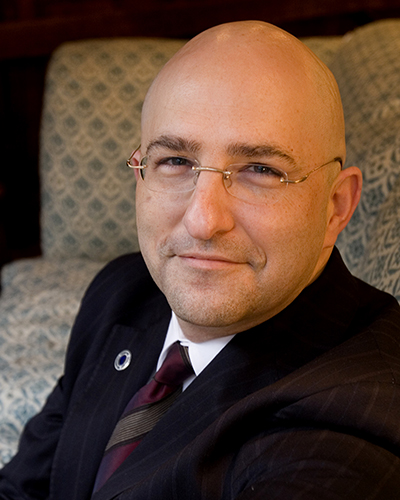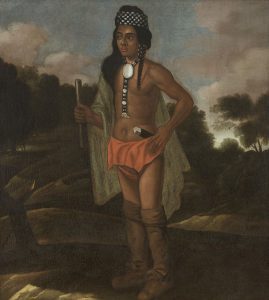A relatively recent treasure added to the NEHGS collections is a late nineteenth-/early twentieth-century oil painting of a Native American sachem. NEHGS purchased this painting in early 2016 from an art dealer. The portrait is traditionally believed to depict Ninigret II (ca. 1610–1677), a sachem of the eastern Niantics, a Narragansett tribe that held extensive lands in what is today Rhode Island.
Ninigret appears to have been a skillful player on the stage of seventeenth-century New England politics. He allied the Niantics with the English against the Pequots in 1637, and kept his tribe out of King Philip’s War in the 1670s. Many historians consider King Philip’s War to be the deadliest war in the history of European settlement in North America in proportion to percentage of the population.
In spite of their best efforts, the Puritans had little success in converting the Niantics to Christianity. Governor Thomas Mayhew of Martha’s Vineyard, who established the first English settlements on that island and Nantucket, asked Ninigret to allow him to preach to the Niantics, to which Ninigret replied, “Go and make the English good first.”
A number of place names in Rhode Island honor Ninigret II, most in or around Charlestown.
At Ninigret’s death, his daughter became sachem; she was succeeded by her half-brother, another Ninigret, who granted a large portion of his people’s lands to the colony of Rhode Island in 1709. In the late eighteenth- and early nineteenth centuries, Europeans increased their colonization of former Niantic land; by 1812, only a small number of Niantics were still living in Rhode Island.
A number of place names in Rhode Island honor Ninigret II, most in or around Charlestown. The most prominent sites are Ninigret Pond and Fort Ninigret, the latter an historic fort possibly built in the seventeenth century by Native Americans or early Europeans. Ninigret himself is believed to be buried at a place near Charlestown called Burying Hill.
Two other known versions of this painting exist: one in the collection of the Rhode Island School of Design (RISD) Museum in Providence, and the other at the Massachusetts Historical Society (MHS) in Boston. RISD’s version, circa 1700, is almost certainly the oldest of the three, and very likely the earliest portrayal of a Native American by a European-trained artist. Curators at the RISD Museum have recently re-identified the artist of their painting as Robin Cassacinamon, an influential Pequot leader whose tribe occupied the basin of Connecticut’s Pequot River, known today as the Thames River. The NEHGS and MHS paintings are very probably later copies of the RISD portrait.
This depiction of Ninigret can also be seen elsewhere. During the nineteenth century engraved copies of the RISD painting were widely distributed throughout the United States. And the public library in Westerly, Rhode Island, contains a beautiful stained glass window of Ninigret. Based on the RISD portrait, the window was designed and installed in 1894, the year the library opened to the public. Anyone can see this lovely window today, rain or shine, as the library has recently re-displayed it with back lighting to simulate perpetual sunshine. And everyone is invited to the Treat Rotunda at NEHGS, where our oil portrait of Ninigret II is proudly on view, resplendent in its new, custom-made frame.
A version of this blog post appeared in American Ancestors 17: 3 [2016].
Share this:

About Curt DiCamillo
Curt DiCamillo, internationally recognized authority on English country houses and the decorative arts, joined NEHGS in February 2016 as our first Curator of Special Collections. A longtime member of NEHGS, Curt has led highly successful heritage tours for us to England and Scotland, lectured extensively in the United States and abroad, and taught classes on British culture and art at the Museum of Fine Arts, Boston. Curt was previously Executive Director of The National Trust for Scotland Foundation USA, where he successfully raised more than $7 million and initiated many innovative programs. As Curator of Special Collections at NEHGS, Curt will provide strategic direction and expert guidance for organizing and exhibiting our extensive collection of family history-related artifacts and fine arts.View all posts by Curt DiCamillo →
